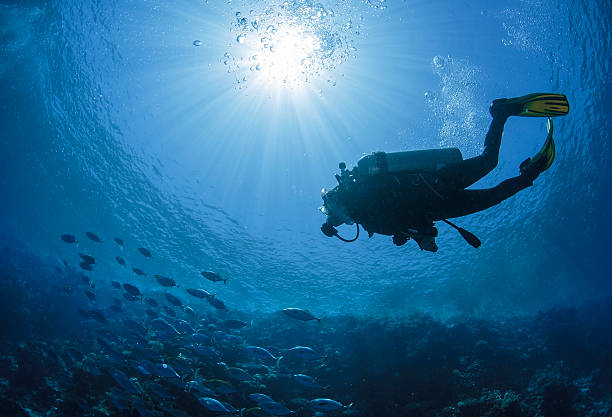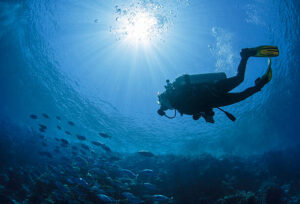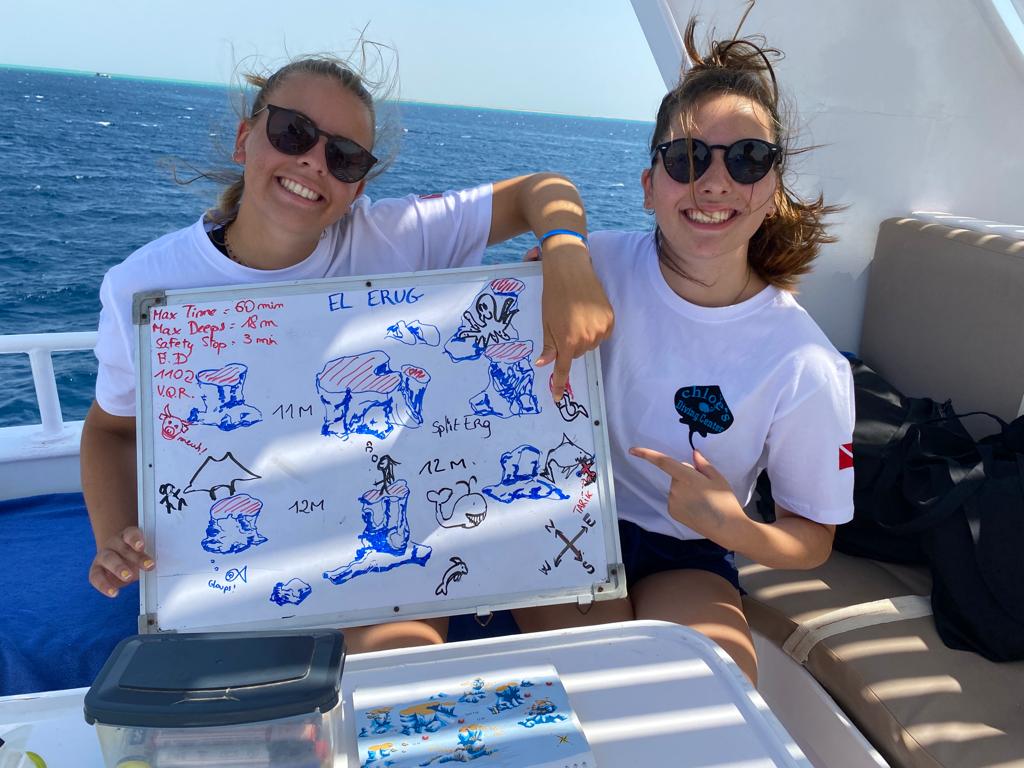How to navigate underwater tips & trips

Doubt immediately crept into my mind. How far were we going to have to swim? What if we took off in the wrong direction? How would the boat crew find us? There are many reasons for bettering your underwater navigation skills, but put simply, it makes it possible for you to find your way home. Natural navigation requires you to use the physical contours and characteristics of the dive site to guide your way out and then find your way back, and learning to combine natural navigation with basic compass skills practically ensures you’ll never get lost underwater. Here are eight steps for getting to the reef or wreck and back again:
1.Get Briefed
Good navigation starts before you even get in the water. If you and your buddy are diving independently, get a thorough site description — and a map, if possible — from a local dive shop or other divers at the site. If you’re on a chartered dive boat, pay close attention to the divemaster’s briefing. He or she can impart valuable information about the site’s features, depth range and currents so you and your buddy can create a dive plan. Discuss your profile and the time or air pressure at which you’ll turn around, and decide on a basic route.
2.Follow The Leader
One diver should take the lead before you even get in the water. It isn’t practical for both divers in a buddy pair to attempt to navigate on a dive. If you’re leading, concentrate on the planned path. Your buddy should monitor time, depth and distance. Start at the beginning If diving from a boat, enter the water and either surface swim to the mooring or anchor line and descend there, or drop down behind the boat and swim underwater to the mooring or anchor. Always start your dive at the point where the boat connects to the bottom. When diving from the beach, surface swim past the waves to where you plan to make your descent. Whether diving from the beach or the boat, natural navigation starts as soon as your head goes under the water. “Upon descent make a good note of natural references like sand patches, rock formations, pillar corals, brain corals or whatever,” If you make mental notes of features you can remember, you can use those physical markers to find your way back.
3.Watch the clock
Swim away from your starting point for a predetermined length of time, and then turn around and swim roughly the same length of time back the opposite direction. If there’s current, head into it on the way out — in this case, the return trip won’t take quite as long. Watch your air consumption as well. It’s a good idea to follow the rule of thirds: Use one-third of your air on the way out, one-third on the way back and leave one-third for exploring near the boat and making a safety stop.
4.Pay Attention
Make note of the unique features or characteristics of the dive site that can make navigating as simple as a walk in the park. For example:
Pick a path: The best navigational marker is a dedicated line you can follow like a hiking trail. At many sites this may be a sand channel or the edge of the reef where it meets the sand. Another easy path to follow is a specific depth contour on a sloped reef or wall. For example, you and your buddy can plan to descend along a sloped reef to 18 meters, then turn, swimming with the reef on your right and maintaining a constant 18 meters depth. To find your way back, turn 180 degrees so the reef is on your left and continue at the same depth.
Look for landmarks: On many dive sites, you’ll find distinct coral formations, objects or differences in the bottom’s contour. Keep an eye out for anything that stands out, and make note of the depth. You may pass a swim-through at 21 meters, an anchor on the seafloor at 27 meters or a sand channel at 12 meters that runs perpendicular to shore. Use these landmarks to guide you on the way back.
Follow the light: “Check the sunlight angle at the start of your dive and try to confirm this when you begin your descent,” If you head into the sun at the beginning of the dive, you should have the sun at your back when you turn around. And if you’re diving off a big boat, look for the boat’s shadow on the seafloor when you think you’re getting close.
Watch the Water: How the water moves can tell you a lot about the general direction you should go. Close to shore, the constant back-and-forth motion you feel as waves pass overhead is called surge. The wave push headed toward the beach is always going to be stronger than the return surge. This will always give you the general direction of the beach. Constant wave action also creates ripples on the sand bottom that run parallel to the shoreline.
5.Check Your Compass
“In tropical waters, even though it’s clear, the ease of seeing what’s around can often lull you into a false sense of security,” You can lose reference easily and get distracted. I’ve known many low-vis divers who’ve had difficulty adapting to tropical-water navigation. They think they can drop the compass and autopilot back to the boat. As you swim, line up the long line on your compass, called the lubber line, with your body and the direction you want to swim. Proper positioning is very important. Hold the compass with two hands in front of your body. Using one hand often allows the lubber line to drift off course, and so will you. You’ll also need to keep the compass flat so the wheel inside can spin freely.
“While swimming, periodically wiggle the compass to make sure it’s level, Do not fixate on the compass, but instead look over and beyond the compass with frequent glances to make sure you don’t drift off course.” When taking a heading, rotate the bezel on top of the compass until the hatch marks meet the North arrow. As long as you keep the compass flat and the North arrow between those marks, you should swim straight. To reverse course, simply turn around until the North arrow points toward the marks on the other side of the bezel.
6.Go Slow
Not only will you pay more attention to where you’re going, you’ll stay closer to the boat or shore, further reducing your chances of getting lost. Honestly, the reef is pretty much the same whether you’re at the boat or 270 meters away, so there’s little reason to go a long distance, and a relaxed attitude will not only help you conserve air, but you’ll be surprised by how much more you see.
7.Take a Peek
At a relatively shallow site, you can always make a normal ascent to the surface and find the boat. If you know you’re lost, this is much better than swimming off in a random direction you think will lead you back. When you do come up away from the boat — and we all do it at some point — listen carefully for boat engines and avoid surfacing if you think a boat is passing nearby. Once on the surface, turn 360 degrees until you see your boat, then give the crew a big two-arm OK, so they know you’re not in trouble.
Like every other skill in diving, practice will make you a first-rate navigator, which will open you up to a wider variety of diving possibilities. And a great way to learn these skills is by taking a navigation class, which provides hands-on training, both on the surface and underwater, and allows you to practice with an experienced navigator (your instructor) and with similarly motivated dive buddies (your classmates).
Share This Post
More To Explore

How To Navigate Underwater Tips & Tricks
How to navigate underwater tips & trips Doubt immediately crept into my mind. How far were we going to have to swim? What if we
Have Any Question? Don't Hesitate To Contact Us!
